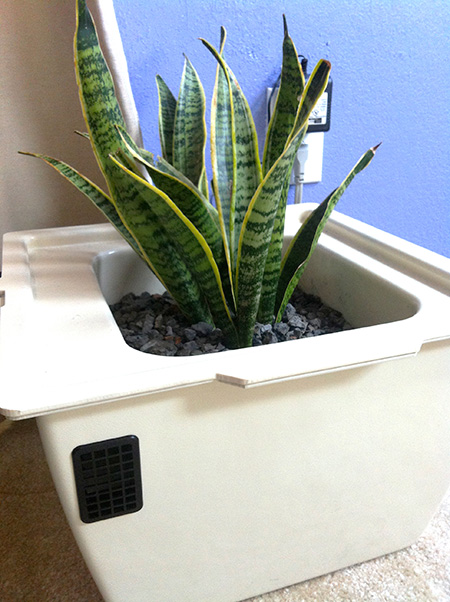Share
Related Topics
Tagged As
It has long been known that plants are beneficial to our environment and health. In elementary school we learned that plants turn carbon dioxide into life-essential oxygen. In everyday life, we use them for nutrition, aesthetics, even medicine, adding to our quality of life.
We do not strictly control Google ad content. If you believe any Google ad is inappropriate, please email us directly here.
While several companies have created plant-based air purifiers, I had the privilege to try one based on the original technology designed by NASA scientist B.C. “Bill” Wolverton. This technology enables the Plant Air Purifier to turn a single plant into a very efficient air purifier, equivalent to as many as 100 plants grown in a traditional soil environment.
How does the Plant Air Purifier make this process more efficient?
The Essentials
A hydroculture (soil-free) environment
The Plant Air Purifier uses a mix of activated carbon and ceramic media instead of traditional potting soil. According to Wolverton’s book (referenced above), a soil-free environment has many benefits since it uses inert materials that are odorless, clean, and dry. A dry environment prevents the growth of fungus that can aggravate allergies, as well as pests and diseases. The media also doesn’t need replacing or refreshing and most importantly, allows air to pass through them more easily than soil.
In the Plant Air Purifier, the water and fan are housed in the outer pot, while the media (“soil”) and plant are kept in the inner pot. Using a water reservoir in a soil-free environment enables the plant to draw up the exact water it needs - no need to worry about under or over-watering.
A fan
Forced air movement is essential to clean an adequate amount of air in a given time. The fan within the Plant Air Purifier’s outer pot moves the indoor air through the filter bed at 24 cubic ft./minute (best suited for a room about 80 sq. ft.) - moving the air through the plant’s root system. There, the activated charcoal holds the VOCs to allow the plant microbes to convert them into oxygen and food for the plant. The clean air then is pushed back into the room. A simple A/C adaptor is used to keep the fan powered.
The Plant
The Plant Air Purifier doesn’t come with a plant, which may seem inconvenient, but it allows a great deal of personal preference. You can choose a plant based on its appearance, air purifying ability, hardiness, price, or a combination of these factors. In my case, I chose an inexpensive, hardy, adaptable snake plant from a local store. The manufacturer recommends the snake plant or a golden pathos plant for beginners.

The Process
Setting up the air purifier is relatively simple but requires some time, patience, and some mess. The first step in setting up is soaking the ceramic media and the activated charcoal. Since I am currently living in a small, one-bedroom apartment with no patio, I went about this task in my bathtub. If you have access to even a small outdoor space, I would recommend using that instead. The activated carbon is very messy and leaves a greasy gray film on everything it touches (rest assured, not a permanent film). Both materials have to be soaked for at least an hour and then mixed together. A big, easy-to-carry bucket or bin works best so you can mix the materials together easily. Both materials also have to be strained before they are mixed, the activated charcoal with a piece of fabric and the ceramic media with the inner pot or something similar.Next, I moved onto the plant. I removed the plant from its original pot and soil. This should be done very carefully so as not to damage or lose any of the roots. All the soil has to be removed from the roots to ensure the plant adjusts. This can be done by soaking the root ball and running the roots under running water. Then as instructed, I cut back a quarter of the root system with sharp scissors to stimulate new growth of “water roots”. Once that was done, I was ready to plant.
I placed a little more than a third of the mixed media into the inner pot. I then gently added additional media to fill in the rest of the space. I had a good portion of extra media that I saved for future use.
Below, I’ve included verbatim the manufacturer’s plant acclimation instructions. These steps will greatly reduce the risk of killing your plant in the setup process.
“Allow your plant to acclimate itself to its new environment for at least two weeks before turning on the fan. After two weeks, begin switching the fan on for 4 to 6 hours a day. This can easily be done with an inexpensive and simple light timer. Three to four weeks after transplanting, your planter can be run up to 12 hours a day. Four to six weeks after transplanting the plant can be run 24 hours a day. Once the fan is turned on, the plant should be monitored for signs of stress. If your plant shows signs of stress, turn your fan off to allow our plant to recover, then slowly increase ON time until you reach your desired hours of operation.”
The Price
If you buy a Plant Air Purifier, it will cost about $229 not including the cost of plant you select, which is minimal in comparison. However, the unit does include the activated charcoal (carbon) and ceramic media, which will serve as your “potting soil”.
You also have to consider, that unlike most air purifier units, there are no expensive filters to replace, in fact, no filters at all to replace. In addition, you shouldn’t have to replace the media because the VOCs are consumed by the microbes - not merely trapped by the activated charcoal.
The Results
Since the one bedroom apartment I live in doesn’t have central air or a ventilation system, it was the perfect environment to test the plant air purifier. Having no other VOC removal system in my home enabled a true test of the Plant Air Purifier’s VOC removal ability.
The most perceptible effect was the lack of built-up smells in the apartment. When the Plant Air Purifier wasn’t running, it would start to get stuffy and the scents from personal care products, food prepared in the kitchen, etc. would build up. However, when the Plant Air Purifier is running, the apartment doesn’t really smell like anything at all.
Besides some perceptive tests, I tested the Plant Air Purifier with a particle counter. While the Plant Air Purifier’s primary function is to remove gases not particles, there was almost a 10% reduction in particle counts. This is a nice perk for allergy sufferers.
The only problematic feature of the Plant Air Purifier was the automatic shut-off when the water reservoir gets low. This is to prevent the plant’s roots from over-drying. However, in a dry climate, this happens quite frequently, and there is no notification except when you suddenly discovered you don’t hear the quiet hum of the purifier anymore.
Overall
This was a very neat product to try. In my research and testing, I discovered a great deal about the abilities of plants, especially their ability to remove harmful gases such as VOCs given off by new products. I would definitely recommend the Plant Air Purifier, especially if your home doesn’t have central air or a mechanical ventilation system , or contains a lot of new items that are still outgassing. It is well worth the investment. This aesthetically pleasing unit will definitely earn its keep as both as attractive plant and a natural VOC remover.
For more information about the Plant Air Purifier, visit their website: http://www.plantairpurifier.com/.
HHI Error Correction Policy
HHI is committed to accuracy of content and correcting information that is incomplete or inaccurate. With our broad scope of coverage of healthful indoor environments, and desire to rapidly publish info to benefit the community, mistakes are inevitable. HHI has established an error correction policy to welcome corrections or enhancements to our information. Please help us improve the quality of our content by contacting allen@healthyhouseinstitute.com with corrections or suggestions for improvement. Each contact will receive a respectful reply.
The Healthy House Institute (HHI), a for-profit educational LLC, provides the information on HealthyHouseInstitute.com as a free service to the public. The intent is to disseminate accurate, verified and science-based information on creating healthy home environments.
While an effort is made to ensure the quality of the content and credibility of sources listed on this site, HHI provides no warranty - expressed or implied - and assumes no legal liability for the accuracy, completeness, or usefulness of any information, product or process disclosed on or in conjunction with the site. The views and opinions of the authors or originators expressed herein do not necessarily state or reflect those of HHI: its principals, executives, Board members, advisors or affiliates.
(Note: The views expressed in this blog post are those of the author, and do not necessarily represent those of The Healthy House Institute, LLC.)









